Boyle J.A. The Cambridge History of Iran, Volume 5: The Saljuq and Mongol Periods
Подождите немного. Документ загружается.

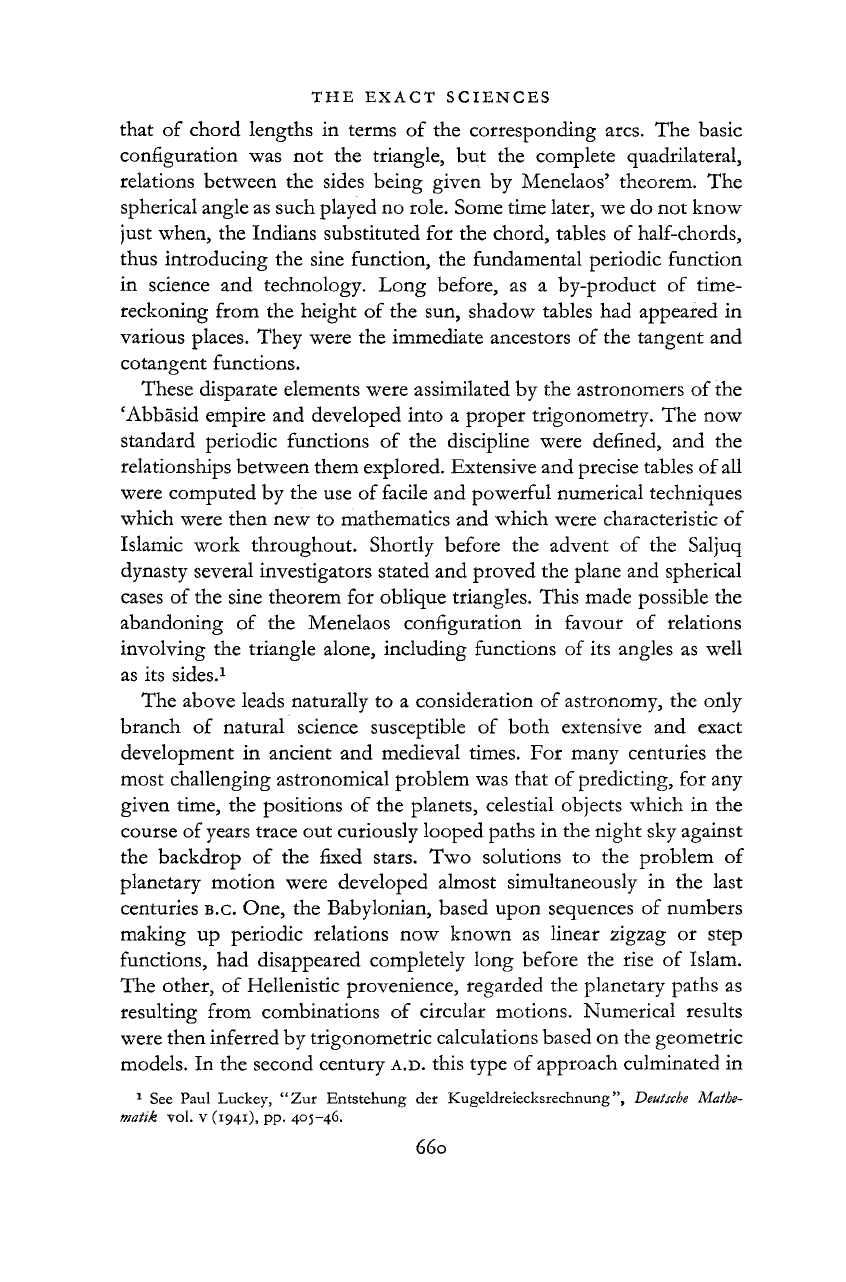
THE
EXACT
SCIENCES
660
that
of chord lengths in
terms
of the corresponding arcs. The basic
configuration was not the triangle, but the complete quadrilateral,
relations between the sides being
given
by Menelaos' theorem. The
spherical angle as such played no role. Some time later, we do not know
just when, the
Indians
substituted for the chord, tables of half-chords,
thus
introducing the sine function, the fundamental periodic function
in science and technology. Long before, as a by-product of time-
reckoning
from the height of the sun, shadow tables had appeared in
various places. They were the immediate ancestors of the tangent and
cotangent functions.
These
disparate elements were assimilated by the astronomers of the
'Abbasid
empire and developed into a proper trigonometry. The now
standard
periodic functions of the discipline were defined, and the
relationships between them explored. Extensive and precise tables
of
all
were
computed by the use of
facile
and powerful numerical techniques
which
were
then
new to mathematics and which were characteristic of
Islamic work throughout. Shortly before the advent of the Saljuq
dynasty several investigators stated and proved the plane and spherical
cases
of the sine theorem for oblique triangles. This made possible the
abandoning of the Menelaos configuration in favour of relations
involving
the triangle alone, including functions of its angles as
well
as its sides.
1
The
above leads naturally to a consideration of astronomy, the only
branch of
natural
science susceptible of both extensive and exact
development in ancient and medieval times. For many centuries the
most challenging astronomical problem was
that
of predicting, for any
given
time, the positions of the planets, celestial objects which in the
course of years trace out curiously looped
paths
in the night sky against
the backdrop of the
fixed
stars. Two solutions to the problem of
planetary motion were developed almost simultaneously in the last
centuries
B.C.
One, the Babylonian, based upon sequences of numbers
making up periodic relations now known as linear
zigzag
or step
functions,
had disappeared completely long before the rise of Islam.
The
other, of Hellenistic provenience, regarded the planetary
paths
as
resulting from combinations of circular motions. Numerical results
were
then
inferred by trigonometric calculations based on the geometric
models.
In the second century
A.D.
this type of approach culminated in
1
See
Paul
Luckey, "Zur
Entstehung
der
KugeldreiecksrechnungDeutsche
Matbe-
matik
vol. v
(1941),
pp.
405-46.
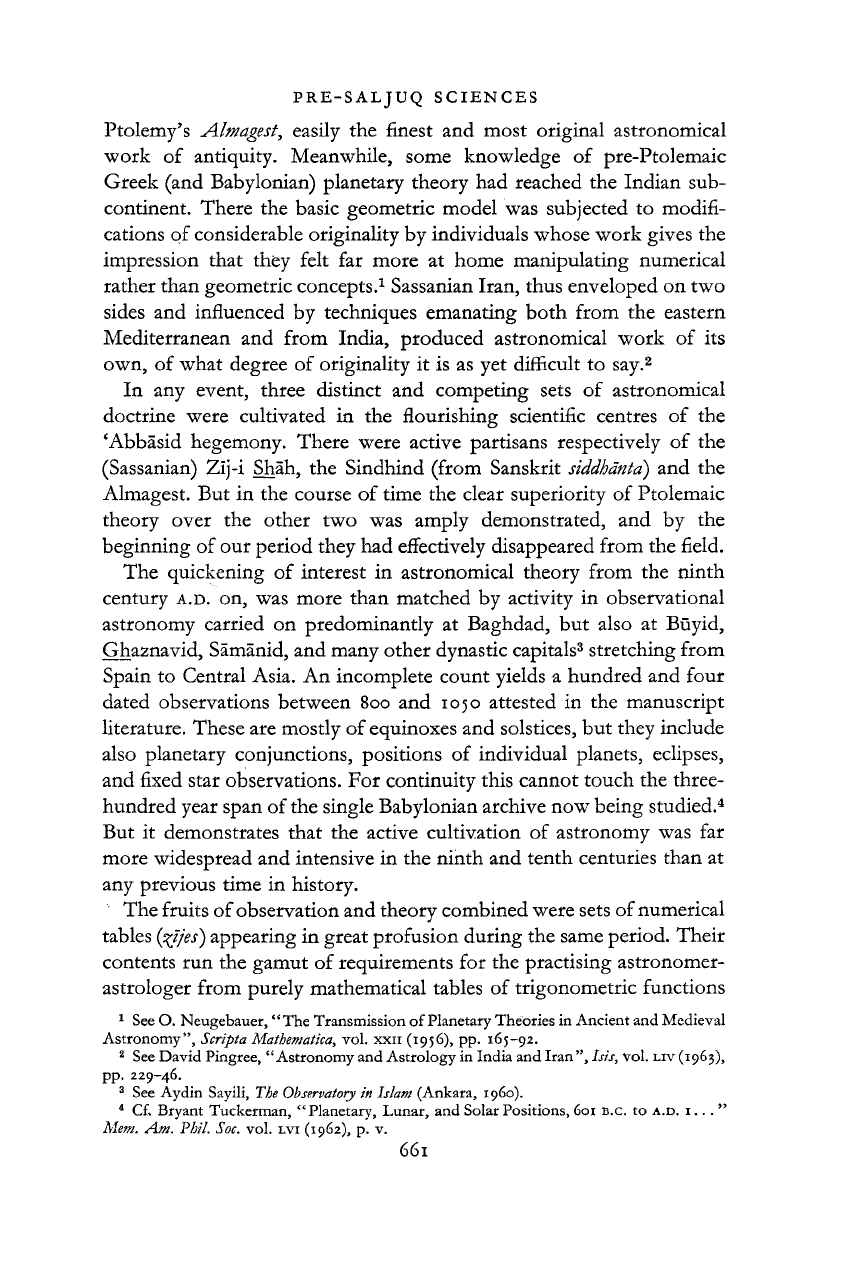
PRE-SALJUQ SCIENCES
Ptolemy's
Almagest, easily the finest and most original astronomical
work
of antiquity. Meanwhile, some knowledge of pre-Ptolemaic
Greek
(and Babylonian) planetary theory had reached the Indian sub-
continent. There the basic geometric model was subjected to modifi-
cations of considerable originality by individuals whose work
gives
the
impression
that
they felt far more at home manipulating numerical
rather
than
geometric concepts.
1
Sassanian
Iran,
thus
enveloped on two
sides and influenced by techniques emanating both from the eastern
Mediterranean and from India, produced astronomical work of its
own,
of what degree of originality it is as yet difficult to say.
2
In any event, three distinct and competing sets of astronomical
doctrine were cultivated in the flourishing scientific centres of the
'Abbasid
hegemony. There were active partisans respectively of the
(Sassanian)
Zlj-i
Shah, the Sindhind (from Sanskrit
siddhanta)
and the
Almagest.
But in the course of time the clear superiority of Ptolemaic
theory over the other two was amply demonstrated, and by the
beginning of our period they had
effectively
disappeared from the field.
The
quickening of interest in astronomical theory from the
ninth
century
A.D.
on, was more
than
matched by activity in observational
astronomy carried on predominantly at Baghdad, but also at
Buyid,
Ghaznavid,
Samanid, and many other dynastic capitals
3
stretching from
Spain
to Central
Asia.
An incomplete count yields a. hundred and four
dated observations between 800 and 1050 attested in the manuscript
literature. These are mostly of equinoxes and solstices, but they include
also
planetary conjunctions, positions of individual planets, eclipses,
and
fixed
star
observations. For continuity this cannot touch the three-
hundred year span of the single Babylonian archive now being studied.
4
But
it demonstrates
that
the active cultivation of astronomy was far
more widespread and intensive in the
ninth
and
tenth
centuries
than
at
any previous time in history.
The
fruits of observation and theory combined were sets
of
numerical
tables
(zz/es)
appearing in great profusion during the same period. Their
contents run the gamut of requirements for the practising astronomer-
astrologer from purely mathematical tables of trigonometric functions
1
See O.
Neugebauer,
"The
Transmission
of
Planetary
Theories
in
Ancient
and
Medieval
Astronomy",
Scripta
Mathematica,
vol. xxn
(1956),
pp.
165-92.
2
See
David
Pingree,
"Astronomy
and
Astrology
in
India
and
Iran",
his, vol.
LIV
(1963),
pp.
229-46.
3
See
Aydin
Sayili,
The
Observatory
in
Islam
(Ankara,
i960).
4
Cf.
Bryant
Tuckerman,
"Planetary,
Lunar,
and
Solar
Positions,
601
B.C.
to
A.D.
1... "
Mem. Am.
Phil.
Soc. vol.
LVI
(1962),
p. v.
661
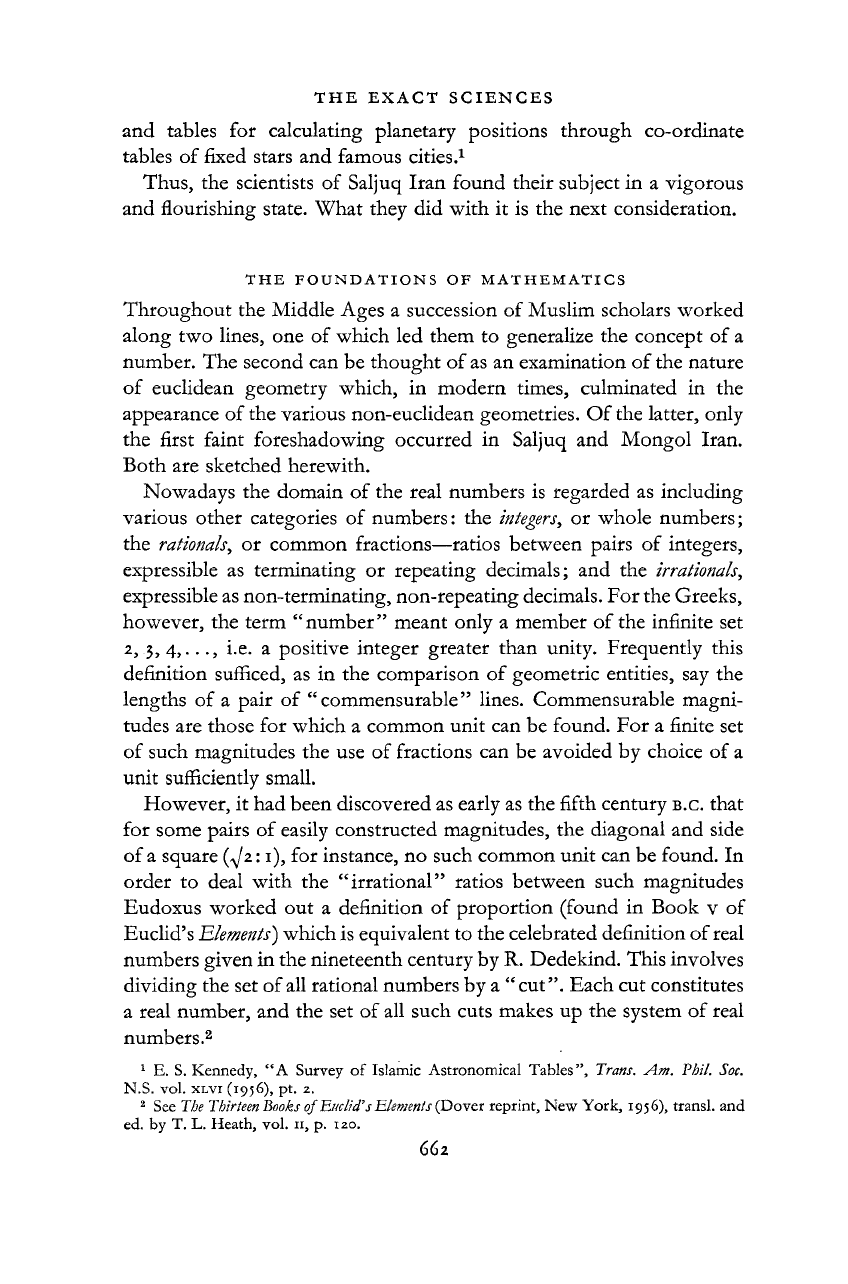
THE EXACT SCIENCES
662
and tables for calculating planetary positions through co-ordinate
tables of
fixed
stars
and famous cities.
1
Thus,
the scientists of Saljuq
Iran
found their subject in a vigorous
and flourishing state. What they did with it is the next consideration.
THE
FOUNDATIONS
OF
MATHEMATICS
Throughout the Middle
Ages
a succession of Muslim scholars worked
along
two lines, one of which led them to generalize the concept of a
number. The second can be thought of as an examination of the
nature
of
euclidean geometry which, in modern times, culminated in the
appearance of the various non-euclidean geometries. Of the
latter,
only
the first faint foreshadowing occurred in Saljuq and Mongol
Iran.
Both
are sketched herewith.
Nowadays
the domain of the real numbers is regarded as including
various
other categories of numbers: the
integers,
or whole numbers;
the rationals, or common fractions—ratios between pairs of integers,
expressible
as terminating or repeating decimals; and the irrationals,
expressible
as non-terminating, non-repeating decimals. For the Greeks,
however,
the term "number" meant only a member of the infinite set
2,
3,4,..., i.e. a positive integer greater
than
unity. Frequently this
definition sufficed, as in the comparison of geometric entities, say the
lengths of a pair of "commensurable" lines. Commensurable magni-
tudes are those for which a common
unit
can be found. For a finite set
of
such magnitudes the use of fractions can be avoided by choice of a
unit
sufficiently small.
However,
it had been discovered as early as the fifth century
B.C.
that
for
some pairs of easily constructed magnitudes, the diagonal and side
of
a square
(^2:1),
for instance, no such common
unit
can be found. In
order to deal with the "irrational" ratios between such magnitudes
Eudoxus
worked out a definition of proportion (found in
Book
v of
Euclid's
Elements) which is equivalent to the celebrated definition of real
numbers
given
in the nineteenth century by R. Dedekind. This involves
dividing
the set of
all
rational numbers by a " cut". Each cut constitutes
a real number, and the set of all such cuts makes up the system of real
numbers.
2
1
E. S.
Kennedy,
"A
Survey
of
Islamic
Astronomical
Tables",
Trans.
Am.
Phil.
Soc.
N.S. vol.
XLVI
(1956),
pt. 2.
2
See The
Thirteen
Books
of
Euclid's
Elements
(Dover
reprint,
New
York,
1956),
transl.
and
ed. by T. L.
Heath,
vol. 11, p. 120.
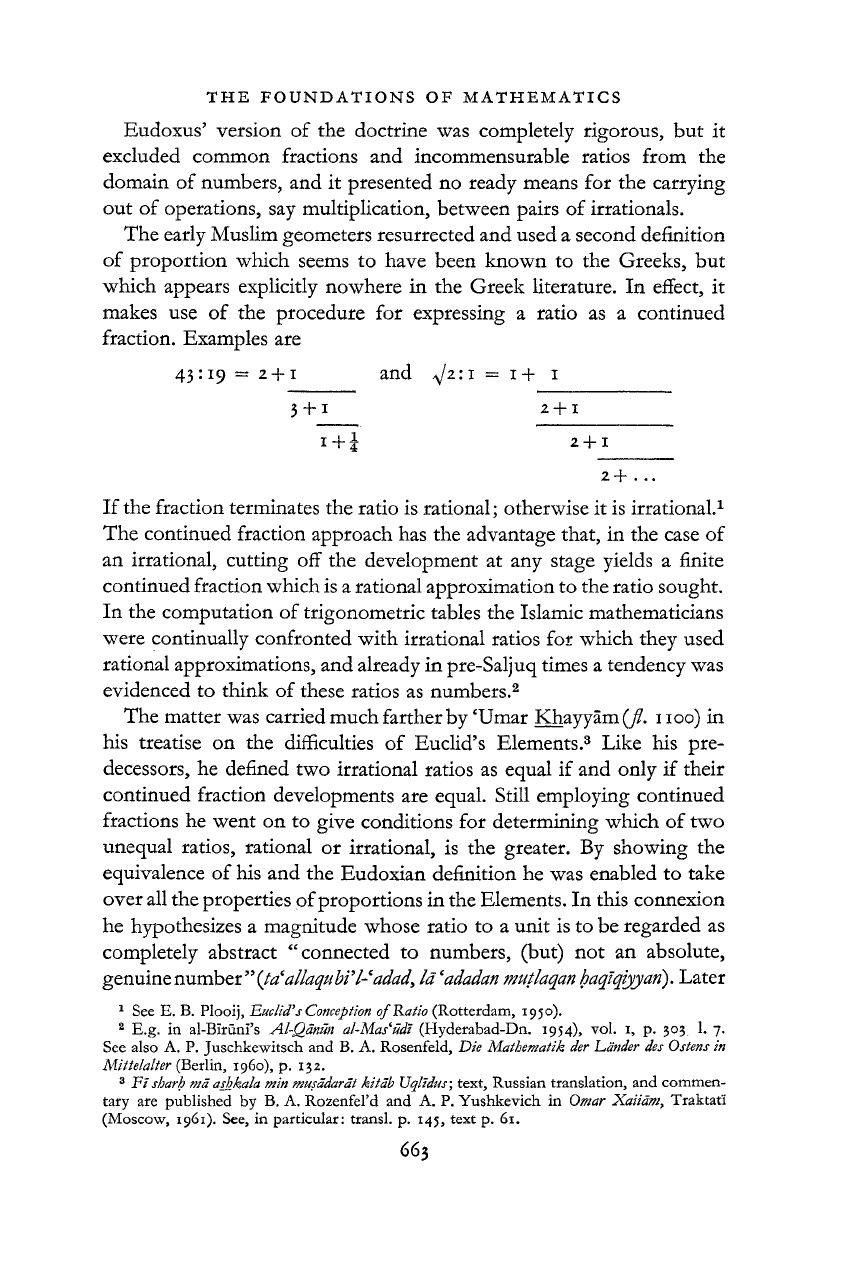
THE FOUNDATIONS
OF
MATHEMATICS
Eudoxus'
version
of the
doctrine
was
completely rigorous,
but it
excluded
common fractions
and
incommensurable ratios from
the
domain
of
numbers,
and it
presented
no
ready means
for the
carrying
out
of
operations,
say
multiplication, between pairs
of
irrationals.
The
early Muslim geometers resurrected
and
used
a
second definition
of
proportion which seems
to
have been known
to the
Greeks,
but
which
appears explicitly nowhere
in the
Greek literature.
In
effect,
it
makes
use of the
procedure
for
expressing
a
ratio
as a
continued
fraction. Examples
are
43:19
=
2
+
1
and ^/2:1 = 1+ 1
3
+
1
2
+
1
i+i
2
+
1
2+
...
If
the fraction terminates
the
ratio
is
rational; otherwise
it is
irrational.
1
The
continued fraction approach
has the
advantage
that, in the
case
of
an irrational, cutting
off the
development
at any
stage yields
a
finite
continued fraction which is
a
rational approximation
to the
ratio sought.
In
the
computation
of
trigonometric tables
the
Islamic mathematicians
were
continually confronted with irrational ratios
for
which they used
rational approximations,
and
already
in
pre-Saljuq times
a
tendency was
evidenced
to
think
of
these ratios
as
numbers.
2
The
matter
was carried much farther by 'Umar
Khayyam
(fl. 1100)
in
his treatise
on the
difficulties
of
Euclid's Elements.
3
Like
his
pre-
decessors,
he
defined
two
irrational ratios
as
equal
if and
only
if
their
continued fraction developments
are
equal.
Still
employing continued
fractions
he
went
on to
give
conditions
for
determining which
of
two
unequal ratios, rational
or
irrational,
is the
greater.
By
showing
the
equivalence
of
his
and the
Eudoxian definition
he
was enabled
to
take
over
all the properties
of
proportions
in the
Elements.
In
this connexion
he hypothesizes
a
magnitude whose ratio
to a
unit
is to be
regarded
as
completely
abstract "connected
to
numbers,
(but) not an
absolute,
genuine number
"
(tcf
allaqub?I-adad, la
'adadan
mutlaqan
haqiqiyyati).
Later
1
See E. B. Plooij, Euclid's
Conception
of
Ratio
(Rotterdam, 1950).
2
E.g. in al-Biruni's Al-Qanun al-Mas'udi (Hyderabad-Dn. 1954), vol. 1, p. 303 1. 7.
See also A. P. Juschkewitsch and B. A. Rosenfeld, Die
Mathematik
der Lander des Ostens in
Mittelalter
(Berlin,
i960),
p. 132.
3
Ft
sharh
ma
ashkala
min
musadarat
kitab
Uqlidus; text, Russian translation, and commen-
tary
are published by B. A. Rozenfel'd and A. P. Yushkevich in Omar
Xaiidm,
Traktat'i
(Moscow,
1961).
See, in particular: transl. p. 145, text p. 61.
663
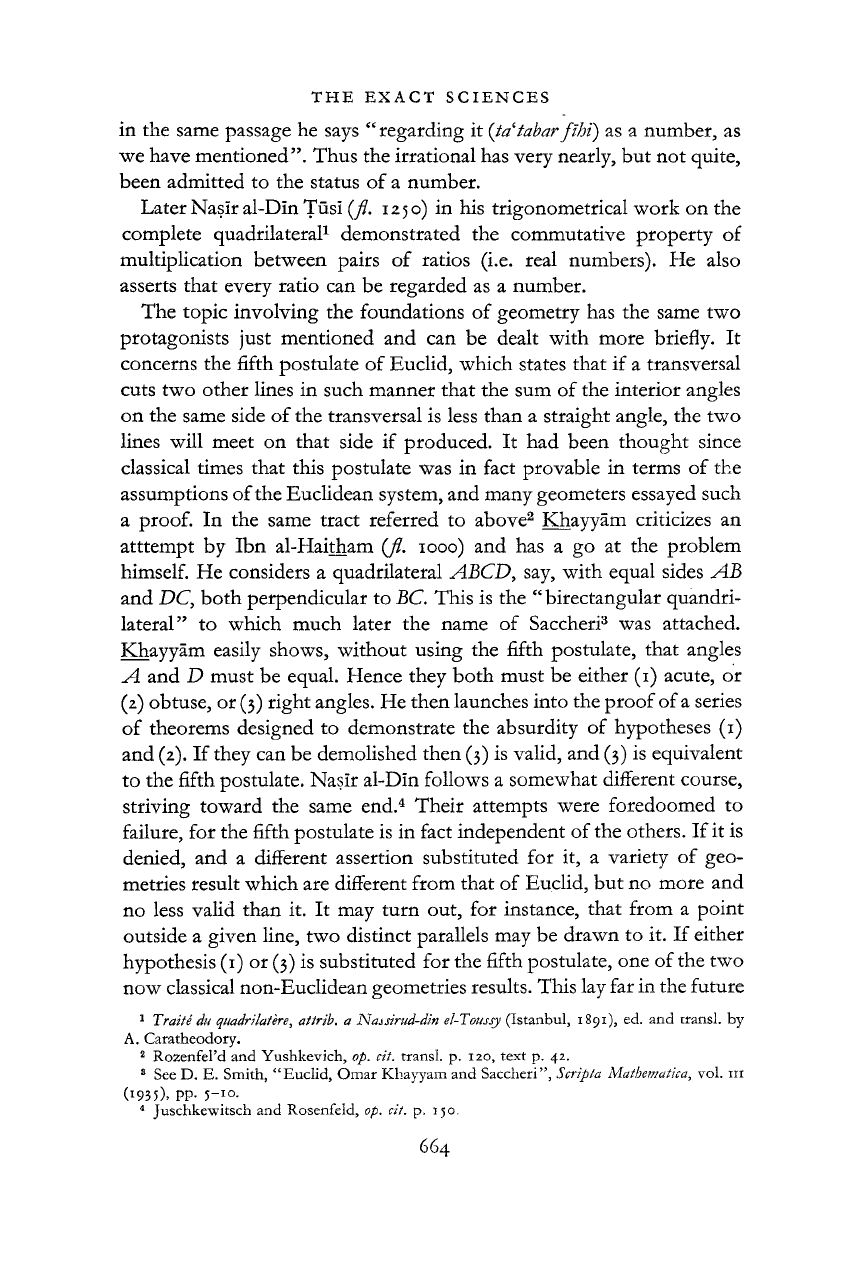
THE EXACT SCIENCES
664
in
the
same passage
he
says
"
regarding
it
(ta'tabar fihi)
as a
number,
as
we
have mentioned". Thus the irrational has very nearly,
but not
quite,
been admitted
to the
status
of a
number.
Later Naslr al-Din Tusi (fl. 1250)
in his
trigonometrical work
on the
complete quadrilateral
1
demonstrated
the
commutative property
of
multiplication between pairs
of
ratios
(i.e.
real numbers).
He
also
asserts
that
every ratio can
be
regarded
as a
number.
The
topic involving
the
foundations
of
geometry
has the
same
two
protagonists just mentioned
and can be
dealt with more briefly.
It
concerns
the
fifth postulate
of
Euclid, which states
that
if a
transversal
cuts two other lines
in
such manner
that
the
sum
of
the interior angles
on
the
same side of the transversal
is
less
than
a
straight angle,
the
two
lines
will
meet
on
that
side
if
produced.
It had
been thought since
classical
times
that
this postulate was
in
fact provable
in
terms
of the
assumptions
of
the Euclidean system, and many geometers essayed such
a proof.
In the
same tract referred
to
above
2
Khayyam criticizes
an
atttempt
by Ibn
al-Haitham
{fl. 1000) and has a go at the
problem
himself.
He
considers
a
quadrilateral
ABCD,
say, with equal sides
AB
and DC, both perpendicular
to
BC. This
is the
" birectangular quandri-
lateral"
to
which much later
the
name
of
Saccheri
3
was
attached.
Khayyam
easily shows, without using
the
fifth postulate,
that
angles
A
and D
must
be
equal. Hence they both must
be
either (1) acute,
or
(2) obtuse, or (3) right
angles.
He then launches into the proof
of
a series
of
theorems designed
to
demonstrate
the
absurdity
of
hypotheses
(1)
and (2).
If
they can
be
demolished then (3)
is
valid, and (3)
is
equivalent
to
the
fifth postulate. Nasir al-Din
follows
a
somewhat different course,
striving
toward
the
same end.
4
Their attempts were foredoomed
to
failure,
for
the fifth postulate is
in
fact independent of the others.
If
it
is
denied,
and a
different assertion substituted
for it, a
variety
of
geo-
metries result which are different from
that
of
Euclid,
but no
more
and
no less valid
than
it. It may
turn
out, for
instance,
that
from
a
point
outside
a
given
line, two distinct parallels may
be
drawn
to it. If
either
hypothesis
(1)
or
(3) is substituted for the fifth postulate, one of the two
now
classical non-Euclidean geometries results. This lay far in the future
1
Traite du
quadrilatere,
attrib.
a Najsirud-din
el-Toussy
(Istanbul,
1891),
ed. and
transl.
by
A.
Caratheodory.
2
Rozenfel'd
and
Yushkevich,
op. cit.
transl.
p. 120,
text
p. 42.
3
See D. E.
Smith,
"Euclid,
Omar
Khayyam
and
Saccheri",
Scripta Mathematica, vol.
111
(1935),
pp. 5~
I
°-
4
Juschkewitsch
and
Rosenfeld,
op. cit. p, 150.
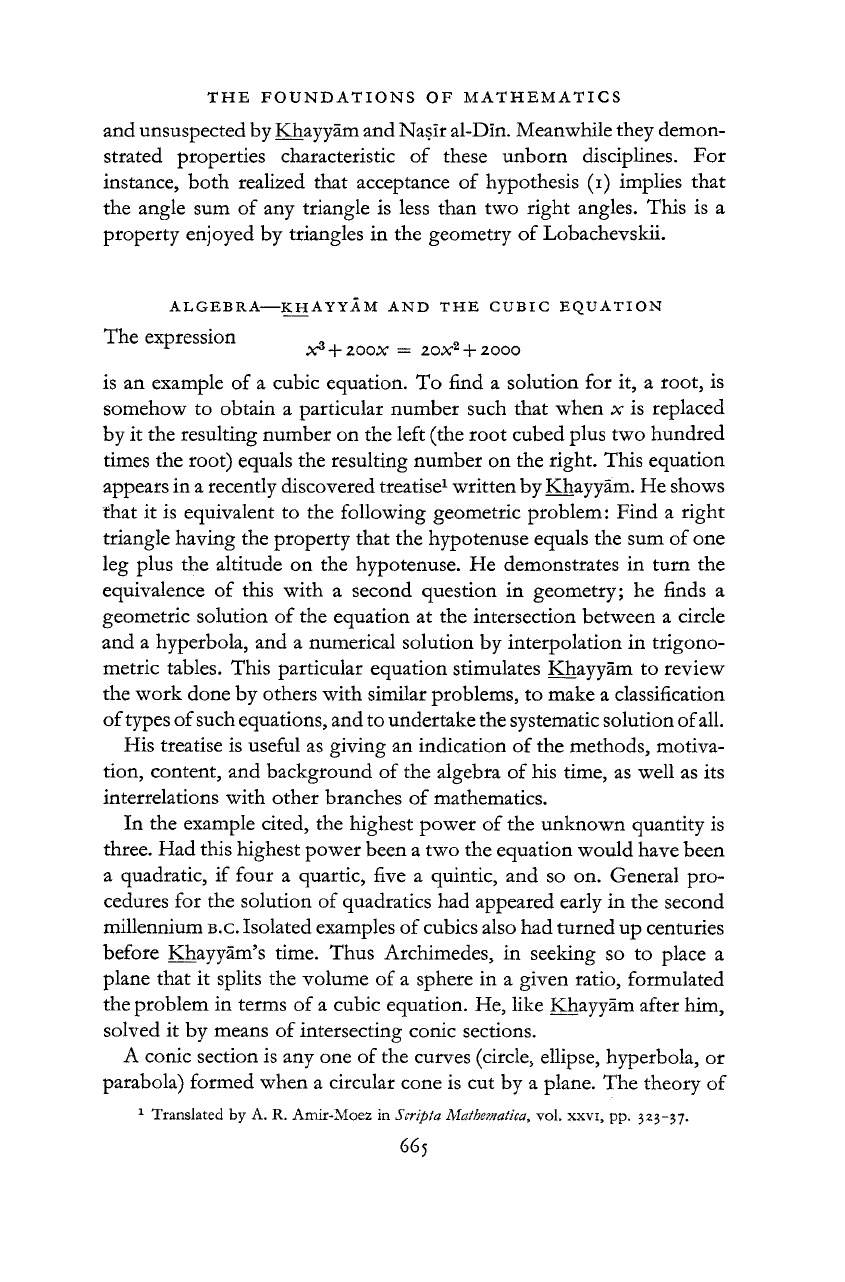
THE
FOUNDATIONS
OF MATHEMATICS
and unsuspected by
Khayyam
and Nasir
al-Din.
Meanwhile they demon-
strated
properties characteristic of these
unborn
disciplines. For
instance, both realized
that
acceptance of hypothesis (i) implies
that
the angle sum of any triangle is less
than
two right angles. This is a
property enjoyed by triangles in the geometry of
Lobachevskii.
ALGEBRA—KHAYYAM
AND THE
CUBIC
EQUATION
The
expression
Q 0
r
XT+ZOOX
=
20X
2
+2000
is
an example of a cubic equation. To find a solution for it, a root, is
somehow
to obtain a particular number such
that
when x is replaced
by
it the resulting number on the left (the root cubed plus two
hundred
times the root) equals the resulting number on the right. This equation
appears in a recently discovered treatise
1
written by
Khayyam.
He shows
that
it is equivalent to the
following
geometric problem: Find a right
triangle having the property
that
the hypotenuse equals the sum of one
leg
plus the altitude on the hypotenuse. He demonstrates in
turn
the
equivalence
of this with a second question in geometry; he finds a
geometric solution of the equation at the intersection between a circle
and a hyperbola, and a numerical solution by interpolation in trigono-
metric tables. This particular equation stimulates Khayyam to review
the work done by others with similar problems, to make a classification
of
types
of
such equations, and to undertake the systematic solution
of
all.
His treatise is useful as
giving
an indication of the methods, motiva-
tion, content, and background of the algebra of his time, as
well
as its
interrelations with other branches of mathematics.
In the example cited, the highest power of the unknown quantity is
three. Had this highest power been a two the equation would have been
a quadratic, if four a quartic,
five
a quintic, and so on. General pro-
cedures for the solution of quadratics had appeared early in the second
millennium
B.C.
Isolated examples of cubics also had
turned
up centuries
before
Khayyam's time. Thus Archimedes, in seeking so to place a
plane
that
it splits the volume of a sphere in a
given
ratio, formulated
the problem in
terms
of a cubic equation. He, like Khayyam after him,
solved
it by means of intersecting conic sections.
A
conic section is any one of the curves (circle, ellipse, hyperbola, or
parabola) formed when a circular cone is cut by a plane. The theory of
1
Translated
by A. R.
Amir-Moez
in
Scrip
fa
Mathematica,
vol.
xxvi,
pp.
323-37.
665
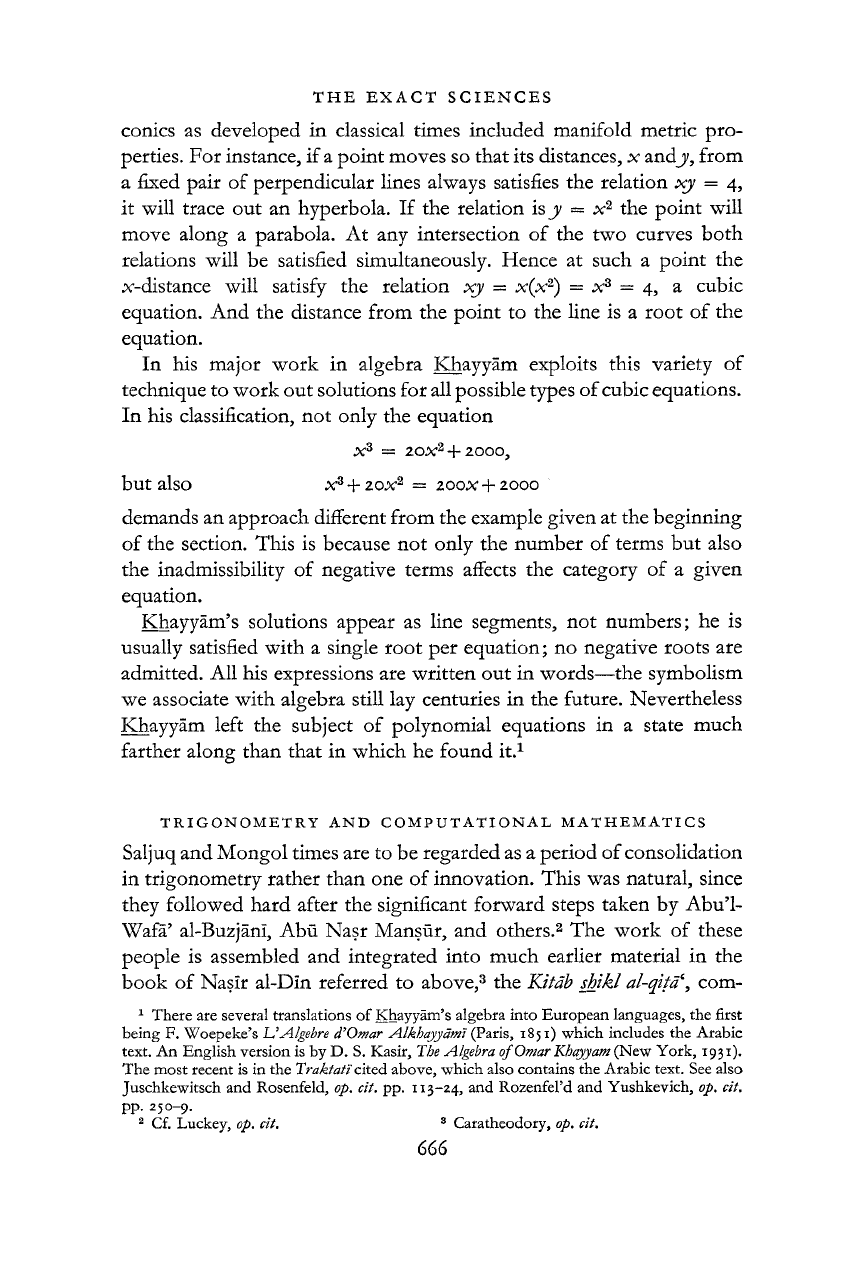
THE EXACT SCIENCES
conies
as developed in classical times included manifold metric pro-
perties. For instance, if
a
point moves so
that
its distances, x andj, from
a fixed pair of perpendicular lines always satisfies the relation xj = 4,
it
will
trace out an hyperbola. If the relation
is
y — x
2
the point
will
move
along a parabola. At any intersection of the two curves both
relations
will
be satisfied simultaneously. Hence at such a point the
^-distance
will
satisfy the relation xy = x(x
2
) = x
z
= 4, a cubic
equation. And the distance from the point to the line is a root of the
equation.
In his major work in algebra Khayyam exploits this variety of
technique to work out solutions for all possible types
of
cubic
equations.
In his classification, not only the equation
X
3
=
20X
2
+2000,
but also
x
3
+
lox
2
= zoox
+
2000
demands an approach different from the example given at the beginning
of
the section. This is because not only the number of terms but also
the inadmissibility of negative terms affects the category of a given
equation.
Khayyam's
solutions appear as line segments, not numbers; he is
usually
satisfied with a single root per equation; no negative roots are
admitted. All his expressions are written out in words—the symbolism
we
associate with algebra still lay centuries in the future. Nevertheless
Khayyam
left the subject of polynomial equations in a state much
farther along
than
that
in which he found it.
1
TRIGONOMETRY
AND
COMPUTATIONAL
MATHEMATICS
Saljuq
and Mongol times are to be regarded as a period of consolidation
in trigonometry
rather
than
one of innovation. This was natural, since
they followed hard after the significant forward steps taken by
Abu'l-
Wafa'
al-Buzjani, Abu Nasr Mansur, and others.
2
The work of these
people
is assembled and integrated into much earlier material in the
book
of Nasir al-Din referred to above,
3
the Kitdb shikl al-qitd\ com-
1
There
are
several
translations
of
Khayyam's
algebra
into
European
languages,
the
first
being
F.
Woepeke's
UAlgebre
d'Omar
Alkhayydmi
(Paris,
1851)
which
includes
the
Arabic
text.
An
English
version
is by D. S.
Kasir,
The
Algebra
of
Omar
Khayyam
(New
York,
1931).
The
most
recent
is in the
Traktat'icited
above,
which
also
contains
the
Arabic
text.
See
also
Juschkewitsch
and
Rosenfeld,
op. cit. pp.
113-24,
and
Rozenfel'd
and
Yushkevich,
op. cit.
pp.
250-9.
2
Cf.
Luckey,
op. cit.
3
Caratheodory,
op. cit.
666
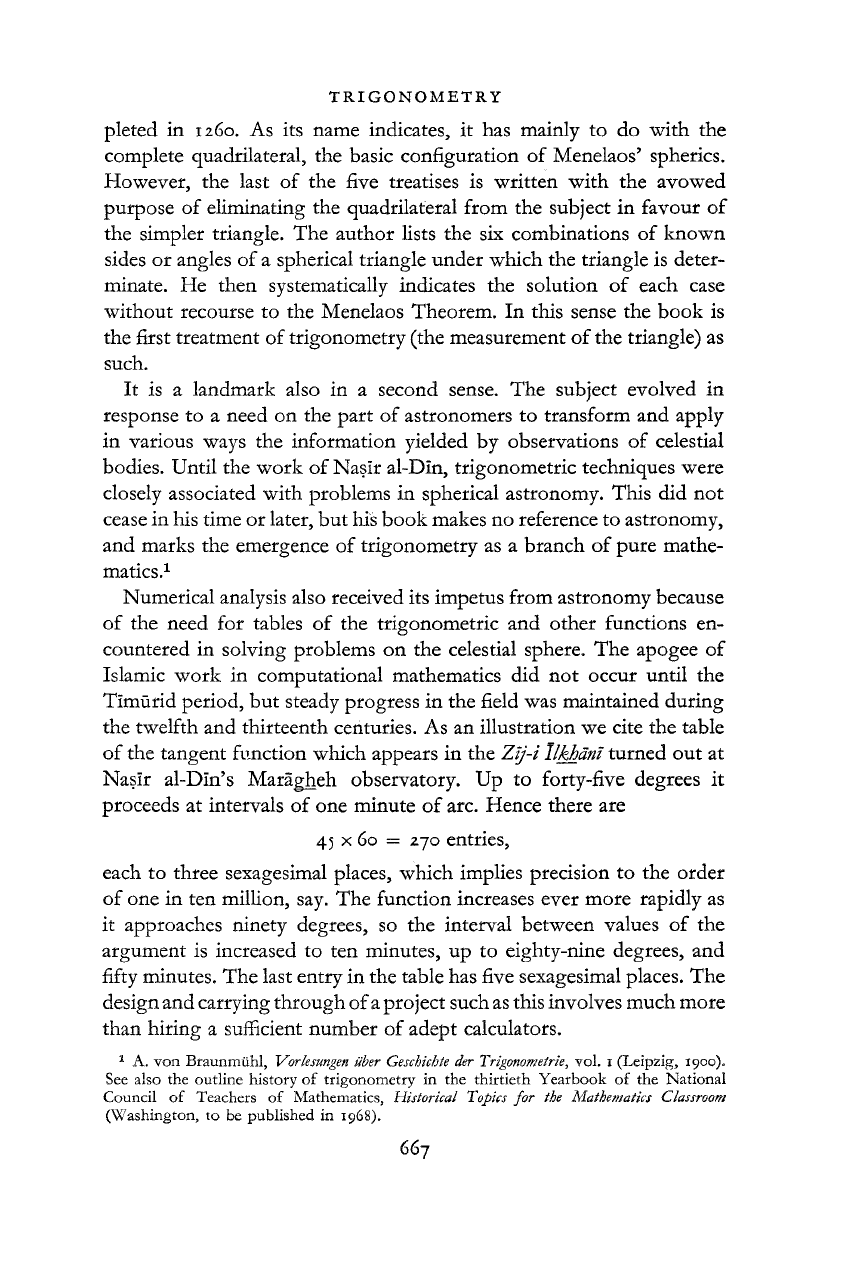
TRIGONOMETRY
pleted in 1260. As its name indicates, it has mainly to do with the
complete quadrilateral, the basic configuration of Menelaos' spherics.
However,
the last of the
five
treatises is written with the avowed
purpose of eliminating the quadrilateral from the subject in favour of
the simpler triangle. The
author
lists the six combinations of known
sides or angles of a spherical triangle
under
which the triangle is deter-
minate. He
then
systematically indicates the solution of each case
without recourse to the Menelaos Theorem. In this sense the book is
the first
treatment
of trigonometry (the measurement of the triangle) as
such.
It is a landmark also in a second sense. The subject
evolved
in
response to a need on the
part
of astronomers to transform and apply
in various
ways
the information yielded by observations of celestial
bodies.
Until the work of Nasir al-Din, trigonometric techniques were
closely
associated with problems in spherical astronomy. This did not
cease
in his time or later, but his book makes no reference to astronomy,
and marks the emergence of trigonometry as a branch of
pure
mathe-
matics.
1
Numerical analysis also received its impetus from astronomy because
of
the need for tables of the trigonometric and other functions en-
countered in solving problems on the celestial sphere. The apogee of
Islamic work in computational mathematics did not occur until the
Timurid period, but steady progress in the
field
was maintained during
the twelfth and
thirteenth
centuries. As an illustration we cite the table
of
the tangent function which appears in the Zij-i Ilkhani
turned
out at
Nasir al-Din's Maragheh observatory. Up to forty-five degrees it
proceeds at intervals of one minute of arc Hence
there
are
45 x 60 = 270 entries,
each to
three
sexagesimal places, which implies precision to the order
of
one in ten million, say. The function increases ever more rapidly as
it approaches ninety degrees, so the interval between values of the
argument is increased to ten minutes, up to eighty-nine degrees, and
fifty
minutes. The last entry in the table has
five
sexagesimal places. The
design and carrying through
of
a project such as this
involves
much more
than
hiring a sufficient number of adept calculators.
1
A. von
Braunmiihl,
Vorlesungen iiber
Geschichte
der
Trigonometrie,
vol. I
(Leipzig,
1900).
See
also
the
outline
history
of
trigonometry
in the
thirtieth
Yearbook
of the
National
Council
of
Teachers
of
Mathematics,
Historical
Topics
for the
Mathematics
Classroom
(Washington,
to be
published
in
1968).
667
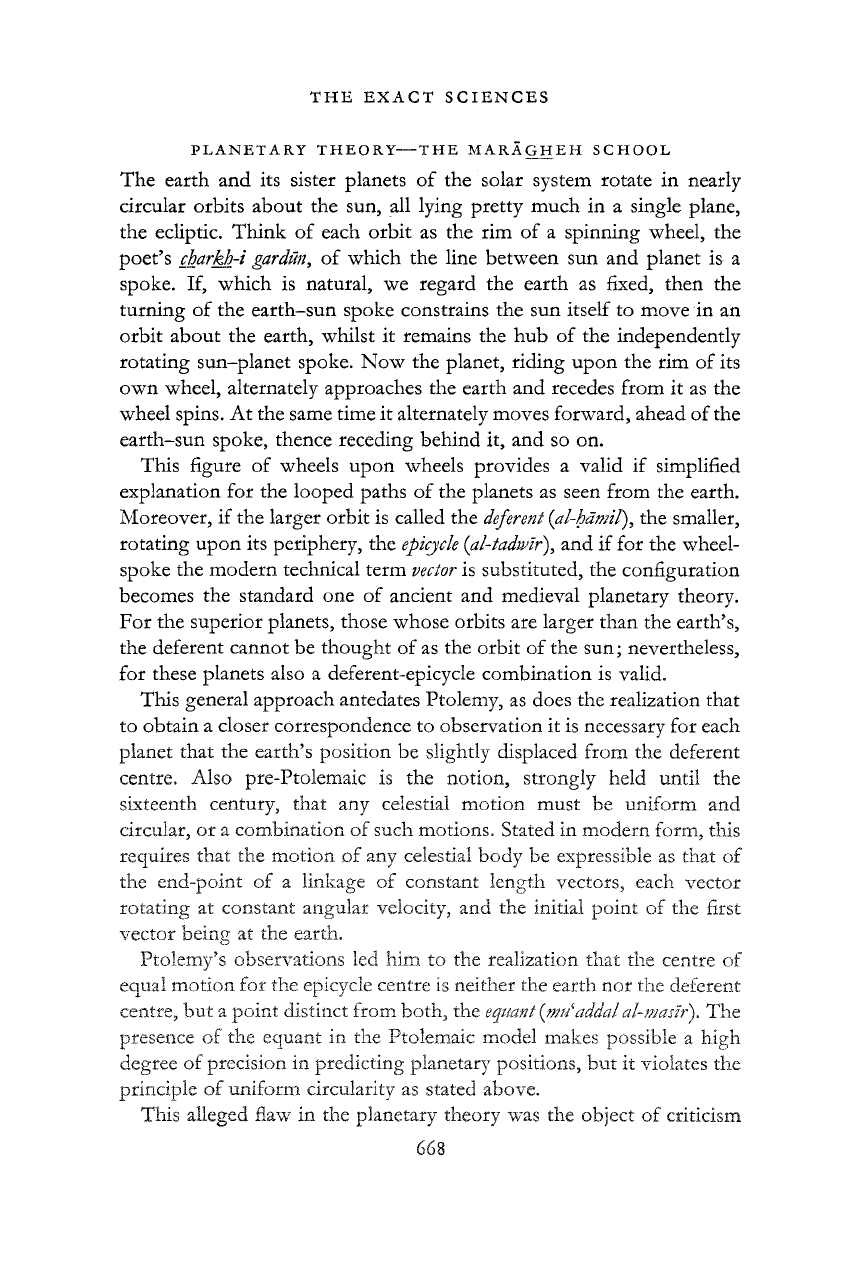
THE EXACT
SCIENCES
PLANETARY
THEORY THE MARAGHEH SCHOOL
The
earth and its sister planets of the solar system rotate in nearly
circular
orbits about the sun, all
lying
pretty much in a single plane,
the ecliptic. Think of each orbit as the rim of a spinning wheel, the
poet's
charkh-i
gardun,
of which the line between sun and planet is a
spoke.
If, which is natural, we regard the earth as
fixed,
then the
turning of the earth-sun spoke constrains the sun itself to move in an
orbit about the earth, whilst it remains the hub of the independently
rotating sun-planet spoke. Now the planet, riding upon the rim of its
own
wheel, alternately approaches the earth and recedes from it as the
wheel
spins. At the same time it alternately moves forward, ahead of the
earth-sun spoke, thence receding behind it, and so on.
This
figure of wheels upon wheels provides a valid if simplified
explanation for the looped paths of the planets as seen from the earth.
Moreover,
if the larger orbit is called the
deferent
{al-hdmil),
the smaller,
rotating upon its periphery, the
epicycle
(al-tadmr\
and if for the wheel-
spoke
the modern technical term
vector
is substituted, the configuration
becomes
the standard one of ancient and medieval planetary theory.
For the superior planets, those whose orbits are larger
than
the earth's,
the deferent cannot be thought of as the orbit of the sun; nevertheless,
for
these planets also a deferent-epicycle combination is valid.
This
general approach antedates Ptolemy, as does the realization
that
to obtain a closer correspondence to observation it is necessary for each
planet
that
the earth's position be slightly displaced from the deferent
centre.
Also
pre-Ptolemaic is the notion, strongly held until the
sixteenth century,
that
any celestial motion must be uniform and
circular, or a combination of such motions. Stated in modern form, this
requires
that
the motion of any celestial body be expressible as
that
of
the end-point of a linkage of constant length vectors, each vector
rotating at constant angular
velocity,
and the initial point of the first
vector
being at the earth.
Ptolemy's
observations led him to the realization
that
the centre of
equal motion for the
epicycle
centre is neither the earth nor the deferent
centre, but a point distinct from both, the
equant {rmfaddal
a
I-m
a
sir). The
presence of the equant in the Ptolemaic model makes possible a high
degree of precision in predicting planetary positions, but it violates the
principle of uniform circularity as stated above.
This
alleged
flaw
in the planetary theory was the object of criticism
668
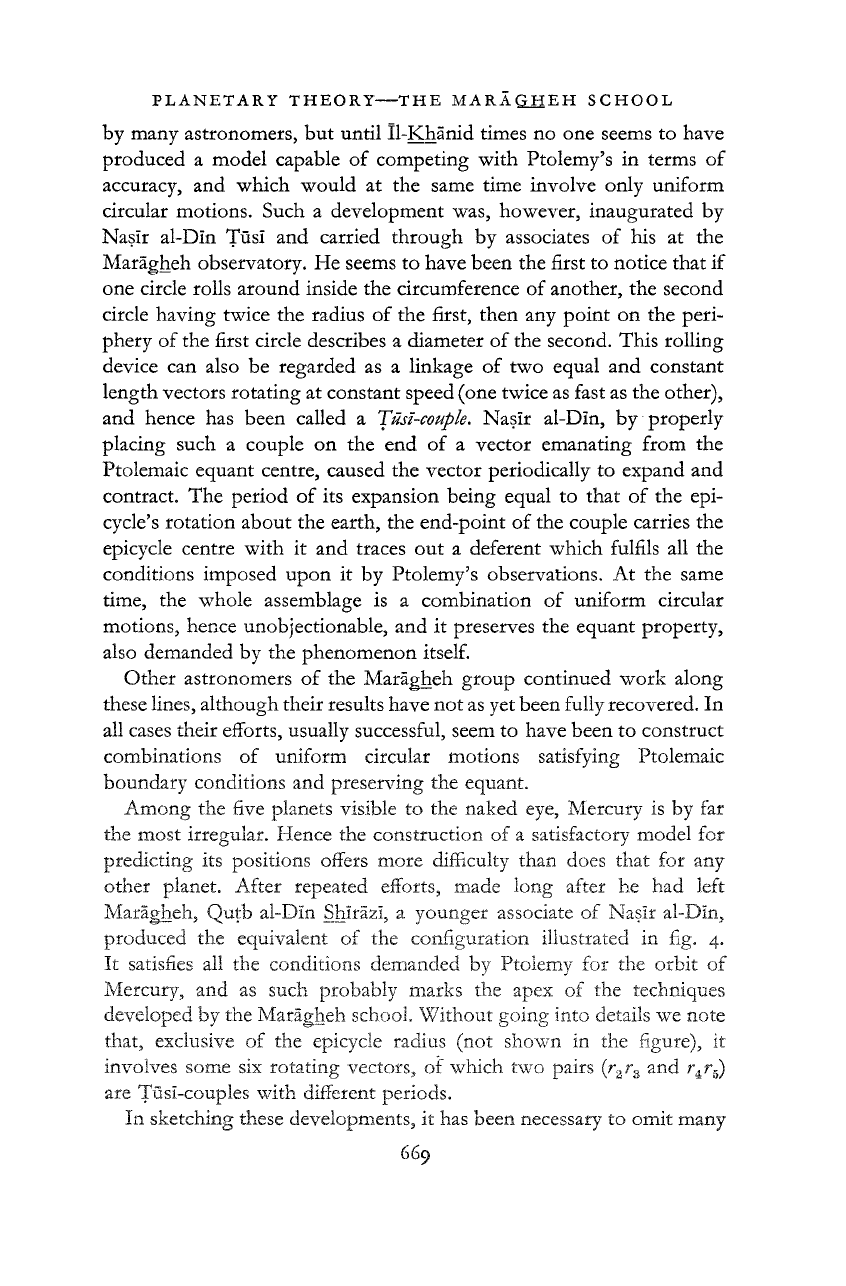
PLANETARY THEORY THE MARAQJIEH SCHOOL
by
many astronomers, but until Il-Khanid times no one seems to have
produced a model capable of competing with Ptolemy's in
terms
of
accuracy,
and which would at the same time involve only uniform
circular motions. Such a development was, however, inaugurated by
Nasir al-Dln Tusi and carried through by associates of his at the
Maragheh observatory. He seems to have been the first to notice
that
if
one circle rolls around inside the circumference of
another,
the second
circle
having twice the radius of the first,
then
any point on the peri-
phery of the first circle describes a diameter of the second. This rolling
device
can also be regarded as a linkage of two equal and constant
length vectors rotating at constant speed (one twice as fast as the other),
and hence has been called a Tusi-couple. Nasir al-Din, by properly
placing
such a couple on the end of a vector emanating from the
Ptolemaic equant centre, caused the vector periodically to expand and
contract. The period of its expansion being equal to
that
of the epi-
cycle's
rotation about the
earth,
the end-point of the couple carries the
epicycle
centre with it and traces out a deferent which
fulfils
all the
conditions imposed upon it by Ptolemy's observations. At the same
time, the whole assemblage is a combination of uniform circular
motions, hence unobjectionable, and it preserves the equant property,
also demanded by the phenomenon itself.
Other astronomers of the Maragheh group continued work along
these lines, although their results have not as yet been
fully
recovered. In
all
cases their efforts, usually successful, seem to have been to construct
combinations of uniform circular motions satisfying Ptolemaic
boundary conditions and preserving the equant.
Among
the
five
planets visible to the naked eye, Mercury is by far
the most irregular. Hence the construction of a satisfactory model for
predicting its positions offers more difficulty
than
does
that
for any
other planet.
After
repeated efforts, made long after he had left
Maragheh, Qutb al-Din Shirazi, a younger associate of Nasir al-Din,
produced the equivalent of the configuration illustrated in fig. 4.
It satisfies all the conditions demanded by Ptolemy for the orbit of
Mercury,
and as such probably marks the apex of the techniques
developed
by the Maragheh school. Without going into details we note
that,
exclusive of the
epicycle
radius (not shown in the figure), it
involves
some six rotating vectors, of which two pairs
(r
2
r
3
and
r
4
r
5
)
are Tusi-couples with different periods.
In sketching these developments, it has been necessary to omit many
669
